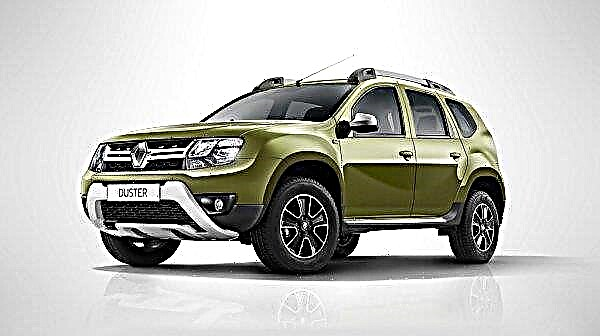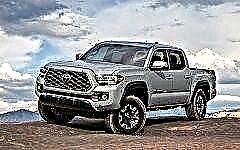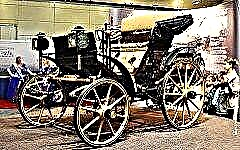

The content of the article:
- The first cars in Russia
The first cars appeared in Russia in the middle of the 19th century. At first, these were "foreign cars" and single developments of Russian craftsmen. Well, in 1896, among the exhibits of the Nizhny Novgorod exhibition, there was the first production car of Russian production, made by the magicians Yakovlev and Frese.
However, in pre-revolutionary Russia, the production of motor vehicles did not take on an industrial scale, and the Russian auto industry really made itself felt only in the era of the USSR. And yet, what interesting things happened at the dawn of the Russian automotive industry?
The first cars in Russia
1. Fast rental

The project of the first steam car in Russia was developed by the talented St. Petersburg engineer Kazimir Yankevich. In September 1830, Yankevich was the first to approach the creation of the so-called self-propelled crew with a steam engine. The invention was simply called fast-rolling.
Actually, it was a tractor designed for towing trailers. The car included a tubular steam boiler invented by Yankevich himself in 1820. This element consisted of 120 smoke tubes and was fueled by pine wood charcoal.
It was assumed that the fast-rolling could be used both in summer, with ordinary wheels, and in winter, with runners. But in practice, it was not possible to establish the movement of this car between the cities of Russia, since then it would be necessary to build not only the crews themselves, but also special roads - with hard surface, large turning radii and not too steep elevation changes.
2. Steam crossover

In 1863, the Russian inventor Avksentiy Vradiy designed an off-road steam self-propelled gun, which was named "Steam locomotive for driving on ordinary roads." All 4 wheels of this unit were driven. Isn't it a prototype of a modern all-wheel drive crossover?
The inventor noted the particular efficiency of his steam power plant. He also convinced the commission, which was presented with a steam self-propelled gun, that this machine can be used to drive on icy roads. That is, a winter version of the device was also envisaged. However, history is silent about whether the serial production of such machines was established.
3. Aveling and Porter. Russian version

In 1873, an English wheeled tractor Aveling and Porter worked at the Maltsovsky plant in the Kaluga province. The seven-ton car had a 6-liter steam unit. from.
However, the factory technicians, having studied the design of the machine, created their own unit with a return of 10 liters. from. and with the possibility of burning wood instead of coal.
A total of seven copies of this tractor were made. He could carry up to 10 platforms with a load of 16 tons. The speed of a loaded road train was 6 km / h, and an empty one - 8.
4. Frese-Yakovlev's car. The king did not please

On July 14, 1896, the first Russian production car assembled in St. Petersburg was exhibited at an exhibition in Nizhny Novgorod. The internal combustion engine and transmission of the model were manufactured by the Yevgeny Yakovlev plant, and the body, chassis and wheels - by the Peter Frese factory. On July 19, Nicholas II surveyed the car, but it did not receive special royal attention.
The highest speed of the Frese-Yakovlev installation was 21 km / h, and the cruising range at one gas station was 20 km. The open body, designed for two riders, was mostly made of wood, as were the wheels, which, however, had rubber tires. And in the headlights there were candles.
1-cylinder 4-stroke engine producing 2 HP with., had water cooling, an innovative electric ignition at that time and two forward gears. The car could not go back.
The car was sold for 1,500 rubles, which was 2 times cheaper than its counterparts from Germany or France. By the way, a decent horse was then valued at 50 rubles, and a worker's monthly salary averaged 25 rubles.
Other vehicle characteristics:
- body type: phaeton;
- weight: 300 kg;
- length: 2450 mm.
5. Revival of the car Frese-Yakovlev

One restored copy of this model was parked in the Polytechnic Museum in Moscow. In addition, in 1996, for the centenary of the first Russian production car in the Scientific and Technical Center of the newspaper "Autoreview", restorers with the support of the editor-in-chief MI Podorozhansky recreated a full-scale copy of the car from drawings and descriptions.
6. Lessner's firm at the auto show

From May 19 to June 4, 1907, the First International Automobile Exhibition was held in the St. Petersburg Mikhailovsky Manege. The Russian auto industry was represented by 38 manufacturers, and the largest collection of cars, chassis and power units was presented to the public by G.A. Lessner's Machine-Building, Iron Foundry and Boiler Plant.
This company received the Big Gold Medal at the exhibition in the nomination "For the establishment of automotive production in Russia." In addition, the car from Lessner was purchased for the garage of Nicholas II.
7. Russo-Balt vs Vesuvius with a hut

C-24/30 - this was the name of the first production car from the Russo-Balt brand, launched on May 26, 1909. The number 24 in this index denoted the calculated horsepower for a 4.5 liter engine, and 30 was the highest for this the same unit.
Later, the C-24 model was replenished with engines of 35 and 40 liters. With a total circulation of 347 copies, this car became the most numerous in the history of the manufacturer.
In 1913, the enterprise produced its first unit on a half-track propulsion device, developed by an engineer from France A. Kegresse who was then in Russia. The all-terrain vehicle, based on the C-24/40 model, was intended for winter trips, was equipped with skis and rubber tracks 32 cm wide with metal ridges installed.
It is curious that Russo-Balt was the first car to reach the summit of Vesuvius. And the reliability of the car is evidenced by an accident that happened during one of the rallies. The driver then crashed into the hut, which made it collapse. The car was not seriously damaged.
8. Eight-wheeled YAG-12

The first Soviet car with a wheel formula 8X8 was manufactured in 1932 in Yaroslavl. They were in a hurry to prepare the daunting car for the 15th anniversary of the October Revolution, and the brand new YAG-12 literally rolled off the assembly line to Moscow, to Red Square.
This truck was capable of transporting 8 tons of cargo off-road, and on asphalt - all 12.
In addition, an eight-wheeled vehicle could overcome one and a half meter trenches, climb hills with a slope of up to 30 degrees, overcome a ford 0.6 meters deep, and drive on half-meter virgin snow.
But in the future, the project was not developed, preference was given to two- and three-axle all-wheel drive vehicles.
Other characteristics of the machine:
- ground clearance: 320 mm;
- fuel tank volume: 164 l;
- fuel consumption per 100 km: 52 l.
9.With four is more convenient

In the photo: Moskvich-400
Initially, the famous "Moskvich-400", designed in the image of the Opel Kadett, was planned as a two-door. However, an incident that occurred when the car was shown to Stalin added two more doors to the model. And the thing was this.
The generalissimo, sitting in the front passenger seat of the Moskvich, invited Vasily Takhtarov, director of the Moscow subcompact car plant, to get into the car as well. Of course, the head of the enterprise was embarrassed to ask Stalin to provide access to the back seat. As a result, the car was made with four doors for greater ease of use.
By the way, the car was not an exact copy of the pre-war Kadett. In particular, the "Moskvich" lacked the semaphore direction indicators on the B-pillars inherent in the German prototype.
Also, the technology of manufacturing car units has changed significantly due to its adaptation to Soviet materials.Whether parts imported from Germany were used in the assembly of the first "Muscovites", historians have different opinions on this matter.
10. The grin was replaced by a smile

In the photo: GAZ-21 Volga
The first three production copies of the Volga were released in October 1956. At the same time, the radiator grilles installed on them differed significantly from the one on the prototype and had vertical grates.
So, after testing, the concept of the Volga was delivered to the Kremlin to be shown to Marshal Georgy Zhukov. They say that then the military leader did not like the full face of the car that looked like a "shark grin". And in a week, the engineers carried out a small restyling of the car: they designed a grill with horizontal blinds and added a star to them.
In general, the GAZ-21 was produced in two body versions: a four-door sedan and a utility wagon. Moreover, for taxis, special modifications of the GAZ-21T and the TS were made for export. They were equipped with taximeters and now nostalgic green lanterns.
And since 1956, the GAZ-21 has often become the hero of Soviet-made films. Such as "Beware of the Car", "Three Poplars on Plyushchikha", and of course, "The Diamond Arm".
The same model has appeared in the music videos for "Kill The King" by "Megadeth" and "Du Hast" by Rammstein. And needless to say that in our time the first Volga is a very valuable rarity.
Conclusion
Automotive fashion is changeable: steam cars have been replaced by gasoline, now there is a trend for electric cars. In the early period of its history, the Russian car industry produced many interesting brands, and some of them are still being produced. But even among the discontinued models, there are rarities that are highly valued. Especially collectors.











